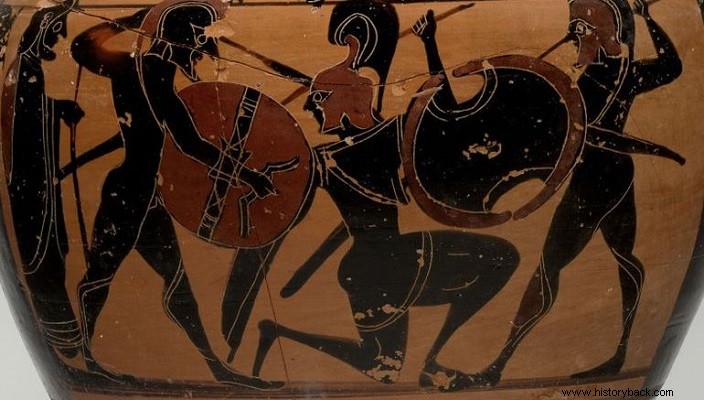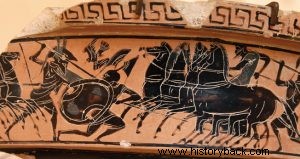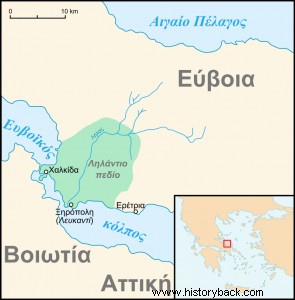
The Lilantian War is one of the most unknown military conflicts in the Greek area. According to the existing sources, it was carried out between 710-650 BC. and many Greek cities took part in it on one side or the other, so many that this war can rightly be characterized as Pan-Hellenic.
The cause of the war was the dispute between Chalkida and Eretria over the possession of the rich Lilantian field, the plain that stretches between the two cities. In generally mountainous Greece, the control of fertile lands was a vital factor for the city that controlled them.
The admittedly reliable Thucydides speaks of a clash of coalitions of cities. "The war between Chalkidos and Eretria divided the other cities of Greece into rival camps," he wrote. There are no exact chronological references to the years of the war. Thucydides places him around 705 BC. The archaeological findings that show the abandonment of sites in the area of the Lilantian field at the same time also agree with him.
After all, we know that until the middle of the 8th c. e.g. Chalkida and Eretria collaborated in the colonial field. Theognis mentions that a war took place in the middle of the 6th c. e.g. However, it seems that his proposal is not correct.
Hesiod and Archilochus they make references to the Lelantian War. Thucydides also refers to him citing his earlier testimonies. Herodotus also mentions that Eretria sent help to Miletus which was threatened by the Persians because Miletus had also helped her in the war against Chalkida. On the contrary, Samos had reinforced Chalkida.
Plutarch also refers to the war and writes that the Thessalian cavalry allied to Chalkida, under Cleomachus, decided the conflict in its favor, despite the death of the Thessalian warlord. Plutarch also mentions a ruler of Chalkida, Amphidamas, who was killed in the war.
Strabo in his "Geographies" he also mentions that the two cities were once on friendly terms but later found themselves at war. Thanks to their old good relations, however, both armies decided not to use small arms.
Archaeological investigations place the start of the war in 710 – 705 BC. as that is when the first burials of warriors found in Eretria date, while the last burials date from around 690 BC. About 680 BC a burial monument for the fallen warriors was created in Eretria.
War and alliances
Chalkida and Eretria were and are both built on the west coast of Evia. Both cities claimed the fertile plain crossed by the Lilas River. But why did the two cities then decide to claim the plain? At the end of the 8th c. e.g. it seems that drought had affected many regions of Greece, including Evia. Maybe that's where the secret lies.
So the conflict broke out and mainly the conflicts took place on land although both naval cities probably had powerful fleets. The men of both armies fought as lancers, armed with shields, swords, spears and javelins. The more affluent also wore bell-shaped brass breastplates and helmets.
However, after firearms were banned, the opposing forces fought in groups, probably in looser formations and not in the formation of an armored phalanx, and that is why the cavalry had such a decisive role in the conflict.
It is possible, however, since the war dragged on for a long time, that the final battles were fought between rival phalanxes. Eretria at the height of her power fielded 3,000 heavily armed infantry, 600 cavalry and 60 light chariots. The number of 600 horsemen for a small town like Eretria is simply huge.
We know nothing of the forces of Chalkida, their number or composition. All we know is that she outnumbered her opponent's infantry, but was outnumbered in cavalry.
Many Greek cities took part in the war on one side or the other. Eretria at that time owned 25% of the territory of Evia as well as the islands of Andros, Tinos and Kea. Also, as mentioned, Miletos fought in favor of Eretria and Samos in favor of Chalkida, as did the Thessalians from Pharsalus.
Historians list up to 40 more cities as participating in the war. It is most likely that Megara, Aegina, Chios and Erythres participated, in addition to those mentioned. But some also connect the Messinian Wars with the Lylandian War, as well as the Argos-Sparti War , with Argos and Aegina supporting Eretria and Sparta supporting Chalkida.
Herodotus mentions that the Samians helped the Spartans against the Messenians. Given the support of Samos towards Chalkida, it seems that there was some correlation, as was the war of Miletus against Sparta's ally Milos.
On the other hand, Corinth and Megara were constantly fighting each other during this period for the possession of the area of Loutraki - Perachora. It seems that Corinth was allied with Chalkida with whom they also cooperated in the establishment of colonies and Megara had sided with Eretria. As for the Asia Minor city of Erythrae, as a rival of Miletus, it was an ally of Chalkida.
About 700 BC Lefkandi, a part of Eretria, was probably destroyed by the Chalcidians, cutting off Eretria from the Lilantian field. At the same time, the Milesians plundered Karystos, in southern Evia, an ally, apparently, of Chalkida.
In the end, it seems that the war, after passing through several stages, ended with the victory of Chalkida, although this is not entirely clear. But it was a literal Pyrrhic victory as both winners and losers were financially ruined and had now lost the keys to commerce.
It seems that the two cities clashed again over the Lilantian field in the 6th century. e.g. Chalkida maintained control of the area until 506 BC. when it came under the control of Athens. In 490 BC after all, Eretria was leveled, after a brave resistance, by the Persians.

Greek warriors of the Archaic Era clash. A chariot can be seen to the right.

